New discoveries by the Thailand Fine Arts Department-University of Hawaii Archaeology Program in Northern Thailand are well on the way to revolutionizing world prehistory. The preliminary results of this program strongly suggest that instead of being an area of passive cultural development, owing all progress to diffusion from China and India, Southeast Asian cultures were the first in the world to domesticate plants and possibly animals; to grind and polish stone tools and to manufacture pottery; and were as early as, if not earlier than, Middle Eastern cultures in the development of copper and then bronze metallurgy (casting), followed by iron casting.
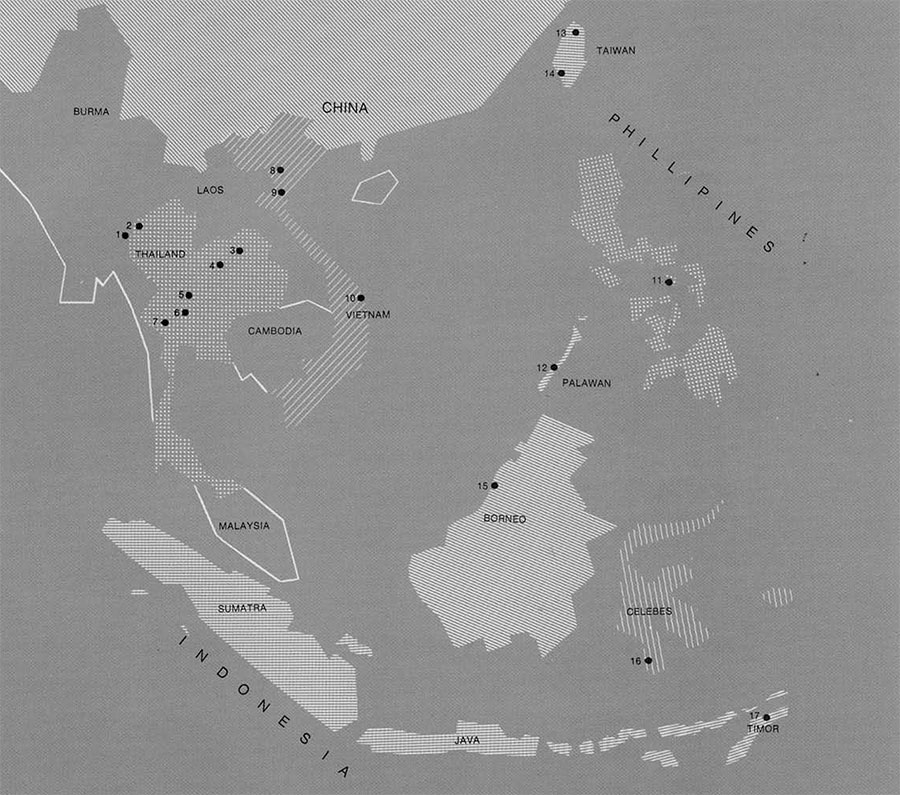
- Padah Lin
- Spirit Cave
- Ban Chiang
- Non Nok Tha
- Khok Charoen
- Lop Buri
- Ong Ba Cave
- Hóa-Binh
- Dông-Son
- Sa-Huynh
- Kalanay
- Tabon Cave
- Yüan-Shan
- Fêng Pi T’ou
- Niah Cave
- Toala Cave Sites
- Portuguese Timor Sites
The field research which most dramatically points in this new direction has been centered in two areas. We first started working in northeastern Thailand in 1963 as a salvage archaeology program supported by the National Science Foundation to investigate archaeologically unknown areas, as far as prehistory was concerned. Nis was in areas soon to be under water as a result of dams being built as a part of the Lower Mekong Development Program. By 1968 the salvage program became problem oriented due to the exciting finds at Non Nok Tha. In 1965 one of lily graduate students, who had worked with me n the northeast in 1963-64, expanded our program to exploration in the north where he discovered Spirit Cave with its astonishingly early dates for probable domesticated and tended plants and quite early dates for a developed pottery.
The traditional reconstruction of Southeast Asian prehistory considers Southeast Asia as a cul-de-sac in the world development of culture. Virtually every type of artifact, and with these the inferred advancements in culture, was said to have been brought into the area by migrations of peoples from the north. In early historic times, about 2000 years ago, the source of cultural innovation supposedly shifted to the west with Indian colonization, or at least an influx of Indian aristocracy, bringing with them Brahmins and advanced technology and founding the first Southeast Asian empires. It was admitted that a number of plants were first domesticated in Southeast Asia, such as banana, coconut, yam, taro, arrowroot and sago, but it was considered that this happened quite late, say the first millennium B.C., in time for the migrants sailing out into the Pacific from Southeast Asia to take these plants with :hem. This domestication of new plants supposedly took place after agricultural techniques and some domesticated plants were brought into southeast Asia from the north. The hypothesis Presented in the 1950’s by Carl Sauer, a geographer, that Southeast Asia was the area in which Plant domestication first took place, was not taken up by the prehistorians or archaeologists.
The Thailand Discoveries
Non Nok Tha
The site of Non Nok Tha was discovered by Chester Gorman at the end of the dry season in 1964. Because the rains were starting and the roads through the western end of the future Ubonrat Reservoir on the Nam Pong (river) west of Khon Kaen were rapidly becoming impassable, Gorman did not have time to test this and two other sites he found in the area. Early in our next field season we made extensive tests of Non Nok Tha which revealed that it was a rich site, with numerous extended burials, and that bronze had apparently been cast at the site, as indicated by a double stone mold for casting an axe, and a number of small pieces of bronze. We started our field season of 1965-66 at Non Nok Tha and excavated in the site for about four months. With partial analysis of the collection over the following year, we realized that we needed further information so Donn Bayard, who had worked with us during the third season, returned for a second excavation there on an NSF predoctoral grant. In charge of the excavation at Non Nok Tha during 1965-66 was Hamilton Parker, a New Zealander who joined the staff of the Department of Anthropology, University of Otago, in Dunedin, New Zealand following this field season. Our program in Thailand since 1968 has been a joint Thailand Fine Arts Department-University of Hawaii-University of Otago undertaking.
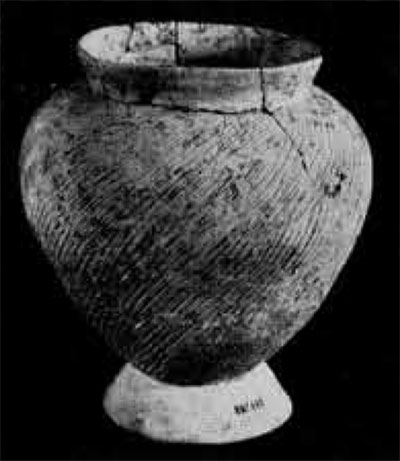
The first excavation showed us that there was a single cultural tradition from the first occupation of the site until its final use previous to its present use as a garden area. This tradition is particularly noticeable in the pottery, which is distinct from any pottery made in Southeast Asia today. The use of cord-wrapped paddles in its manufacture produced cord-marked pottery from the first to last use of the site.
Two distinct periods of use became apparent while the excavation was in process. The upper half of the site (there was generally about 1.80 meters of culture-bearing soil) contained cremation burials in cord-marked jars which had been placed at the bottom of small pits, remnants of iron artifacts, a very few bronze artifacts, bones primarily of small animals, and a few porcelain and stoneware sherds showing contact with surrounding areas. The lower half of the site contained no iron but in its upper portion much evidence of the local production of bronze tools over an extended period of time. Small stone adzes were common. There was considerably more animal bone than in layers from the top half, and from larger animals. Some of this bone was found placed with the earlier burials, including in several cases bone of some kind of bovine. In the lowest levels there were a number of stone tools but no metal and there was nicely decorated pottery which was not found above the fourth layer from the bottom.
Analysis of the collected data is soon to be completed and we have made new finds in the process. There are clearly three different periods into which the cultural continuum can be divided. The latest period corresponds to the top half of the site, as mentioned above. At Non Nok Tha this began at about A.D. 1100. There is a considerable gap, probably around 800 years, between the bottom level of this period and the last previous occupation of the site at around A.D. 300. During this time Buddhism had come into the area with its cremated burials, and we hypothesize an economic change from dry to wet rice agriculture. The only skeletal remains of water buffalo are from this period.
The early half of the site we divide into an early and middle period. From C-14 and thermoluminescence dating (from the University of Pennsylvania) we date the beginning of the middle period around 3000 B.C., or shortly thereafter, lasting until about A.D. 300. Bronze is being used and locally manufactured throughout this period, without the local presence of iron. The site, as in the other two periods, was not occupied continuously and we hypothesize that this was a slash and-burn farming economy with hunting and collecting adding an important element to the diet. There is no indication of the processing of ore at the site, only the casting. Possible sources for copper and lead, two components of this bronze, are found in the northeast within 100 kilometers and tin, the third component, is found in Laos another hundred or so kilometers away. From this we hypothesize that there must have been a trade network in bronze, or in the three separate metals, in Southeast Asia from at least the first working of bronze at this site.
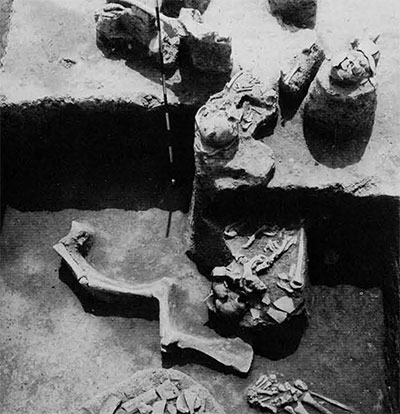
The early period at Non Nok Tha is represented in the deepest three levels and came to an end at about 3000 B.C. We have no secure dating for these levels but we now feel that the first occupation of the site occurred during the first half of the fourth millennium B.C. or possibly in the fifth. Rice (Oriza sativa, probably Japonica) was present from the earliest use of the site as demonstrated by impressions of the husk found in potsherds from the deepest level. It is not yet known whether this rice is wild or domesticated, wet or dry. From burials dug down from the bottom level have come bones of dog, pig and cow, all probably domesticated. The cattle remains appear to be of Bos indicus, the zebu cattle of India; this is the earliest dating of this species yet reported.
The burials of the earliest levels contained the only well-done, incised and impressed decorated pottery from this site. Simple, crude incising over cord-marking, found on a vessel in one burial with several of the best decorated jars, continues into e early part of the middle period. A copper-pocketed tool was found on the chest of a skeleton from a burial in the top early level. Preliminary analysis of this copper indicates that it contains arsenic and iron. This suggests that the copper there had at least been heat-worked to refine the copper to be used for cold hammering, if indeed had not been cast. The tool could be an axe or possibly a kind of spade.
In the same level as the copper tool, and the following first level of the middle period, we found three painted jars with ring feet. While considerable change is evident between each of the three levels and even a greater difference between the early and middle periods as a whole, the basic similarity of the artifacts and the burials indicates at the first occupants of the site were not newcomers to the ecological situation at Non Nok Tha. They had earlier made the major adjustments to is piedmont ecological niche after moving out the small mountain valleys used by the people the Hoabinhian technocomplex, which I hypothesize as being the ultimate source of the Non Nok Tha culture.
Spirit Cave
Spirit Cave, when it was discovered by Gorman in 1966, was the farthest west that any northern Hoabinhian site had been found. The Hoabinhian culture was first defined on the basis of the stone tool types from cave and rock shelter sites in northern Vietnam. These sites were usually found in mountainous country, in limestone formations near small streams. Since the first definition, similar sites have been found in South China, Laos, Thailand, northern Malaya and since 1967 in eastern Burma not far west of Spirit Cave, and in Cambodia. A few sites with the typical Hoabinhian tool kit and associated faunal remains have been found in large shell mounds not far from the coast in northern Vietnam, northern Malaya, and Sumatra. Some forms of typical Hoabinhian tools have been found as far north as Mongolia and Japan, in Island Southeast Asia, particularly western Indonesia, and in Australia. While first considered as Upper Paleolithic, the Hoabinhian has come to be considered as a primitive Mesolithic culture found completely in the Holocene. It was felt that the cord-marked pottery usually found in the upper portion of Hoabinhian sites was not a product of the Hoabinhian people and that the small amount of edge grinding of stone tools resulted from Hoabinhian contact with lowland farmers. Physically, they were considered to be the ancestors of the present-day Melanesians.
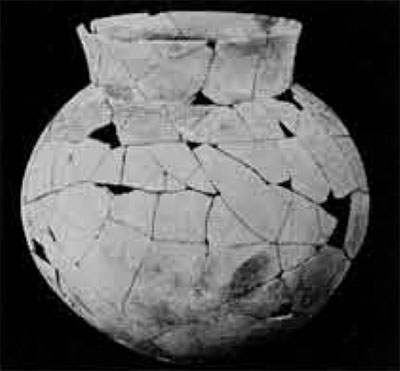
Spirit Cave is a fairly typical Late Hoabinhian site; it lacks one typical element and has two atypical tools. The common stone tools are crude according to European and Middle Eastern standards of stone technology. The core tools tend to be flaked on only one side with the original surface unaltered on the other. The usual grinding stones are present and many used flakes which do not conform to a pattern. It is only in the last few years that archaeologists have realized that many of the common flakes reported found in Hoabinhian sites were used as tools. The great majority of these are un retouched but microscopic examination of the edges shows damage or wear from use. The usual faunal remains of bones from a wide variety of animals, broken into small pieces, and freshwater shells complete the inventory. The element lacking is the edge grinding, to sharpen and straighten a working edge of a few of the typical stone tools. The top layer in the site has three new artifacts added to this inventory: pottery, partly polished rectangular adzes and small slate knives, the latter two being atypical of the Hoabinhian sites.
Previous to Gorman’s excavations in Spirit Cave, no one had thought to look for plant remains in Hoabinhian sites. As his problem for his Ph.D. thesis, Gorman was looking for a Hoabinhian site to test Sauer’s hypothesis that plant domestication had taken place in Southeast Asia in a cultural context very much like that presented by the Hoabinhian. He screened all of the excavated soil through fine screens and found carbonized seeds and shells from nuts and gourds. Identification of these finds by Douglas Yen, an ethnobotanist in the Anthropology Department of the Bishop Museum in Honolulu, showed that among the finds were: two different kinds of bean and a pea which were probably domesticated, Chinese water chestnut, black pepper, a cucumber, areca nut (used in betel chewing in Southeast Asia today), bottle gourd, and several other nuts and tended plants that are still important in Southeast Asia. Much of the broken bone had not been burned, suggesting cooking in bamboo and the typical Southeast Asian system of cooking with vegetables and hot spices. Much of today’s Southeast Asian life style is indicated in Spirit Cave from its first use.
Carbon-14 samples were sent out for dating, but we did not start to receive the dates for over a year. When they arrived we found that we were dealing with the late Pleistocene and early Holocene and thus that the level of plant utilization by the people of Spirit Cave was earlier than in the Middle East. Gorman now has a total of 13 dates, all internally consistent. The earliest occupation has still not been dated, but it is before 10,000 B.C. The new elements of pottery, the rectangular adzes, and the slate knives enter the Spirit Cave assemblage at about 7000 B.C. The pottery is well made and some of it is decorated by incising. It is not a primitive pottery but one with considerable history behind it. Gorman feels that the slate knives were probably used for harvesting a cereal crop, possibly rice, and in his excavation in progress as this goes to press, he is looking for further evidence on this.
Other Thailand and Burmese Evidence
Several other international archaeological expeditions have been working in Thailand since 1960 and the Fine Arts Department, besides working with these, has been making independent excavations. At Lopburi the Thai National Museum excavation directed by Vitya lntakosai, and at Chansen, the Fine Arts Department-University of Pennsylvania excavation led by Somporn Yupho and Bennett Bronson have found iron artifacts from the first occupation of these sites, both around 1200 B.C. (thermoluminescence dating by University of Pennsylvania). At Lopburi there are heavy, socketed axes, generally similar to the bronze axes of Non Nok Tha. Both of these sites are towards the eastern edge of the central plain. The second Thai-Danish Expedition in 1965, led by Per Sorensen, excavated a Late Hoabinhian site in Ongba Cave in west central Thailand. A C-14 date slightly earlier than 9000 B.C. has been reported from that site. The Late Hoabinhian site of Padah Lin in Burma, excavated by the Archaeological Survey of Burma under the leadership of U Aung Thaw, has a C-14 date of about 11,500 B.C. from one of its earlier levels.

A very nice painted pottery with a variety of spiral decorations in red on a tan background was excavated by Vitya for the National Museum at Ban Chiang, northeast of Non Nok Tha. Bronze artifacts have been found in this site but of what association is not known. Three thermoluminescence dates have been made on pottery from this site by the University of Pennsylvania. One of these is 4700 B.C. and the other two are from the middle of the fourth millennium B.C. There are definite similarities between this pottery and the three painted vessels found at Non Nok Tha, but they are far from identical.
New Data from Elsewhere in Southeast Asia
Archaeological research in both Mainland and Island Southeast Asia supports the need for a new interpretation of the region’s prehistory. I will mention only five of the countries where important excavations were made during the 1960’s though important results have come from all the Southeast Asian countries.
North Vietnam has had many new excavations, for the first time made by Vietnamese archaeologists. From this work we now know that there are one or two bronze using and manufacturing cultures which are antecedent to the well-known “Dongson Culture,” which had previously been thought of as the first “Bronze Age” culture in Southeast Asia. The spread of this culture was hypothesized to have brought bronze and associated geometric designs into most of Southeast Asia during the second half of the first millennium B.C. Carbon-14 dates for the earlier bronze now go back to about 1600 B.C. and I expect earlier dates to be forthcoming. The geometric designs that supposedly came in with bronze manufacture, either from Chou China or through migrations from western Asia, are now shown to be those found in the early Non Nok Tha, Ban Chiang, and even Spirit Cave pottery of several thousand years earlier, and as pottery decoration during the second millennium B.C. and earlier in Island Southeast Asia.
Excavations in Formosa, the Philippines, Sarawak, Indonesia and Portuguese Timor have produced the geometric decoration on pottery mentioned above, from the second, and in Formosa the third and earlier millennia B.C. The Formosan excavations have identified two different cultures, one in the north and the other in the south, both appearing around 2500 B.C. Clearly below both of these cultures, and distinct from them, was found the Corded-Ware Culture, so named by the director of these excavations, Chang Kwang-chih, after the cord-marked pottery which is a part of the cultural assemblage. Chang suggests that at both sites where this was found it had come to an end by about 3000 B.C.; that it had come in much earlier, and that it was a derivative of the culture in northern Mainland Southeast Asia and South China which made cord-marked pottery, most likely the Hoabinhian. He further suggests that slash-and-burn agriculture was a part of the economy. Some of the cord-marked pottery was incised with two or three of the geometric patterns used on the Dongson bronzes.
The Sa-huynh-Kalanay Pottery Tradition is the name I gave to a group of pottery complexes which have these geometric patterns of decoration on a small amount of their pottery. Sa-huynh is an archaeological site on the west coast of Annam, in South Vietnam, and the Kalanay Cave site is on the island of Masbate, in the central Philippines. Major sites in which this pottery has been found are the Tabon Cave sites in Palawan, the Philippines. and the Niah Caves in Sarawak.
It has also recently been reported from sites in Portuguese Timor and southwestern Celebes, excavated by archaeologists from the Australian National University and the Indonesian Archaeological Institute. This pottery is related in some way to the pottery of the Lapita Pottery Tradition found in Melanesia and probably to pottery found in Madagascar, and is therefore associated with the Malayo-Polynesian-speaking peoples who populated the whole of the Pacific and reached as far west as Madagascar.
A New Terminology for Southeast Asian Prehistory
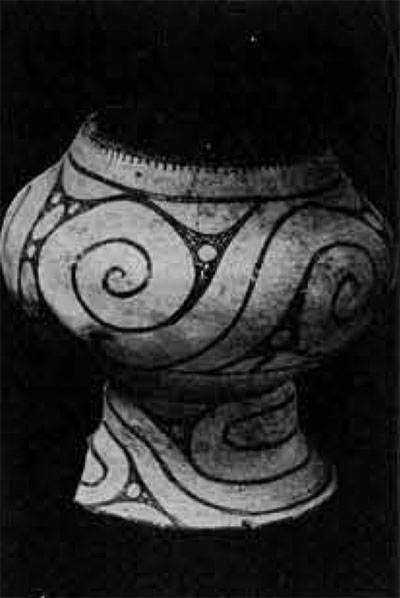
The general subdivision of the prehistoric evolution of man’s culture into Paleolithic, Mesolithic, Neolithic, Bronze Age and Iron Age has been used for classificatory purposes since these terms were first invented during the last century. It was generally felt that they were applicable to the cultures of prehistoric man the world over. These new data, with their early dates, do not fit this general scheme. In fact, the forcing of the Southeast Asian data into this pattern is the primary reason for the interpretation that Southeast Asian cultures were primitive and far behind the cultures of China, India and the West.
I recently suggested a new terminology for subdivisions of Southeast Asian prehistory, with only the first of these subdivisions a stage which it shares with the West. The others I consider as periods specific to Southeast Asia (which includes China south of the Tsinling Mountains, until about 2000 years ago) and have named them after the most important cultural developments going on during the period. These are hypothesized and briefly are as follows:
- Lithic. This is the universal stage (and the only one) during man’s evolution when he lived by hunting and gathering, probably living in small family groups. In Southeast Asia the primary artifactual evidence left by the people of this stage is crude, primarily unifacial core and flake tools and numerous utilized flakes. This began with man’s first entry into the area (if he did not evolve locally) by 1,900,000 years ago and lasted until 42,500 years ago.
- Lignic. This period in Southeast Asia saw a change from a focus on stone as the primary tool material to wood with tool evolution of more importance in wood than in stone. Bamboo was very possibly the most important wood used at first. This period equates with the Early Hoabinhian, beginning (by definition) 42,500 years ago and ending 22,500 years ago. The Early Hoabinhian developed directly out of the generalized culture of the Lithic Stage.
- Crystallitic. During the Crystallitic Period there was a crystallization of distinct local cultures out of the generalized Early Hoabinhian culture of Mainland Southeast Asia and the as yet unnamed and undefined culture(s) of eastern Island Southeast Asia (which was at this time still partly joined with the mainland as a portion of the Sunda Shelf) where there was a much greater use of stone flake tools than core tools. The beginning of this period, at about 22,500 years ago, marks the invention of stone grinding and polishing of the working edge of a few typical Early Hoabinhian stone tools; this distinguishes the Middle Hoabinhian. More importantly, the Middle Hoabinhian had incipient horticulture. It came to an end about 15,000 years ago with the first domestication of plants and at about the same time as the invention of pottery, during the Late Hoabinhian. The Crystallitic Period came to an end about 10,000 years ago (at which point I start using B.C. dates), but not the Late Hoabinhian.
- Extensionistic. About 8000 B.C. one or more cultures became truly distinct from the Late Hoabinhian because of movement of peoples out of the narrow limestone valleys into piedmont areas, probably with cereal agriculture as their economic base but still very dependent on hunting and collecting. This is the end of the Pleistocene with the drowning of the Sunda Shelf by the rising oceans. Late Hoabinhian peoples living along the coasts of the Sunda Shelf were forced back to the new coast lines, both in island and Mainland Southeast Asia. I have hypothesized that it was these peoples who domesticated yams, taro and other vegetative plants we think of as Southeast Asian. This was a period of gradual movement, of expansion into new ecosystems and adjustments to them. Around 4000 B.C., utilizing the outrigger canoe, the movement commenced which ultimately brought people to all the islands of the Pacific and to Madagascar; it also made some contact by Southeast Asians with Japan and Korea. Also around 4000 B.C., somewhere in the interior mainland, copper smelting and casting was invented and around 3500 B.C. bronze had been invented and was being cast into socketed axes. Here Southeast Asia becomes much more complicated, with Late Hoabinhian cultures continuing side by side with much further developed cultures and the unusual situation of many extremely varying, yet in some ways similar, cultures continuing until today in relatively close proximity.
- Conflicting Empires. Though Southeast Asian cultures apparently had all of the necessary foundation for civilization with its warfare and power politics, the peoples of Southeast Asia, except possibly in northern Vietnam, did not develop this themselves but preferred to keep their local independence and relatively peaceful ways (headhunting was widely practiced). Not until the intrusion of people and ideas from India, around 2000 years ago, did the conflicting empires start to develop. This period continued until about 1950 when the last major European (which had gradually replaced most of the local empires between about 1550 and 1900) and Japanese remnants of empire disappeared. Let us hope that this is truly the end of the period of Conflicting Empires and that after a few more years of readjustment, the old and truly indigenous Southeast Asian independent spirit (minus the headhunting) will return.
